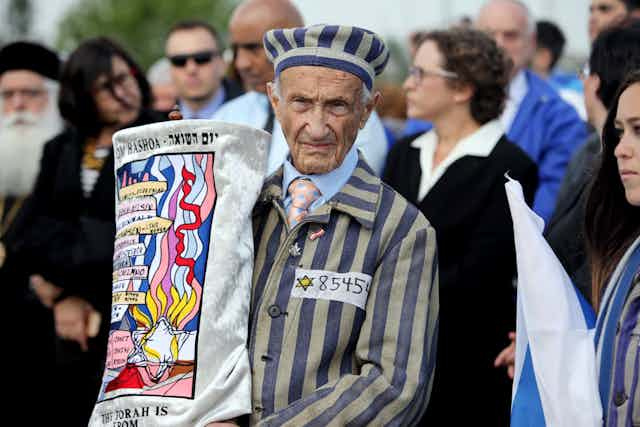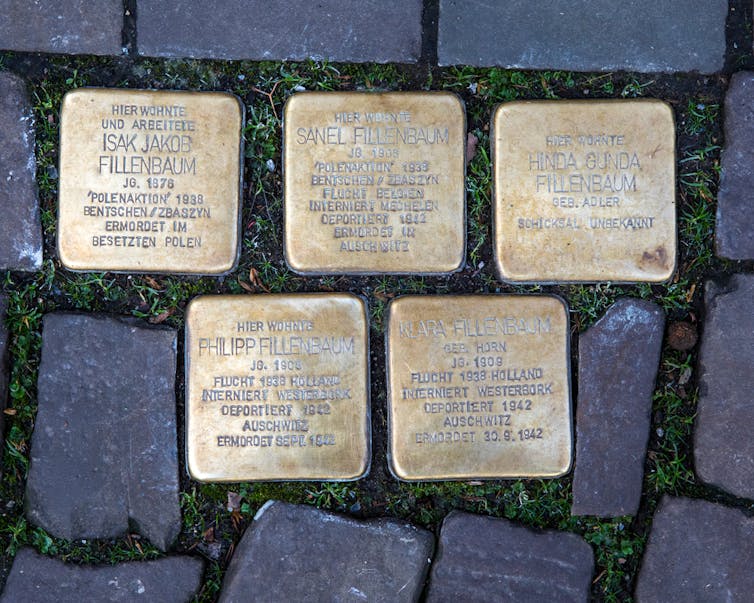
In ancient Rome, the saeculum, or “the age”, was the span of living memory, the telling of an event passed down from the oldest to the youngest. Recognising this profound idea, some have worried that the memory of the Holocaust will fade as the generation of those who survived it near the end of their lives.
Survivors are the core witnesses, the human link to the past. Many work tirelessly in Holocaust education and all rightly deserve our praise and support. Members of their families have sometimes followed suit, sharing publicly the stories of their parents or grandparents. This provides a sense of the emotional force of the Holocaust.
But we are not ancient Romans. While stories passed down through generations are significant, they are not our only connection to the past. Instead, today, the Holocaust is made present in many ways.

chrisdorney
In his 1993 work, The Holocaust as Culture, the survivor and Nobel laureate Imre Kertész argued that the Holocaust will “remain through culture, which is really the vessel of memory”. The discipline of history, invented in its modern form in the 19th century, gives witnesses a crucial role. It supplements their testimony with scholarly research, archival investigations, rules of evidence and forms of argument.
Across the world, in museums, schools and public spaces, the work of memorialisation goes on, too. London’s new Holocaust memorial and education centre is to be completed by 2025. Elsewhere, artists, archeologists, writers, filmmakers, musicians and philosophers produce works that reflect on what happened. The memory of the Shoah is not going to fade.
As time passes and the role of culture broadly understood becomes more important, though, we risk something more dangerous: not forgetfulness but mythmaking.
We are familiar with the myths pedalled by antisemites and racists, who use Holocaust denial as a vector for their hate. Of perhaps greater concern, however, is the mythmaking that seems well-intentioned.
The Irish author John Boyne has said that his novel, The Boy in the Striped Pyjamas, teaches “empathy and kindness”. In his prefatory author’s note, he effectively excuses the extraordinary historical inaccuracies in his book by suggesting that it tells an “emotional truth”.
The emotional truth about the Holocaust, however, is that nine-year-old Jewish boys, like his protagonist Shmuel, were gassed on arrival at Auschwitz. The emotional truth is that nine-year-old sons of SS colonels, like his protagonist Bruno, were turned into antisemites and longed to be old enough to claim their Hitler Youth daggers, inscribed with the phrase “blood and honour”.
What the emotional truth of the Holocaust is not is that victims and perpetrators became friends and were somehow equivalent, as Boyne’s novel implies. The problem with implying this is that the idea takes hold. In October 2022, following fierce criticism online, the London-based Icarus Theatre Collective cancelled a planned Romeo and Juliet set in Nazi Germany. In Shakespeare’s Verona, the “two households” were alike in dignity. In the Third Reich, one attempted to strip all human dignity from the other. Boyne was right to subtitle his novel “A fable”. Works like his risk making the Holocaust itself a fable.
The opposite idea – a ban on art which addresses the Holocaust – presents risks of its own. Culture is how we reflect, how we come to understand and pass on our shared past to help us prepare for the future. In his 1983 work, Reflections on Nazism, the great Holocaust historian Saul Friedländer argued that works of art can present the “reality of the past in a way that sometimes reveals previously unsuspected aspects”. They can tell us something new about the Holocaust, and so, about ourselves.
We navigate between making the Holocaust a fable and banning any representation by talking about, arguing over and even calling out fables of the Holocaust. Myths are received in hushed awe. The past, by contrast, demands to be discussed. Sometimes these discussions can be, perhaps should be, uncomfortable, but even in this discomfort, the memory of the Holocaust is kept alive.
Post a Comment